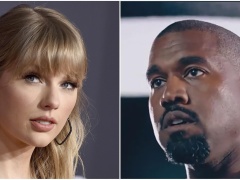
The worlds of Swifties and Deadheads might not seem to have a great deal in common. There may not be that many music fans who’ve registered equal numbers of spins on their Spotify playlists for “Shakedown Street” and “Cornelia Street,” or “St. Stephen” and “Hey Stephen,” or “Althea” and “Dorothea.” Yet there’s reason to fantasize that these two audiences were really separated at birth, even if their average age of Taylor Swift and Grateful Dead concert attendees wouldn’t automatically suggest that these are identical-twin fandoms.
What they share is a powerful and abiding interest in the power of live. And it’s not just about catching one show. Differently scaled as they are, Swift’s two-year Eras Tour and Dead & Company’s three-month residency at Las Vegas’ Sphere stand out out as the two most transfixing concert phenomena of the moment for similar reasons: because each gig in these respective runs is so stamped as its own individual, one-of-a-kind occasion that, for true fans, FOMO is literally a nightly thing. If you’re a true believer but can’t attend very many of either artist’s shows (and who, short of a trust-fund baby, can?), you’re still logging in obsessively to watch fan-generated livestreams or clips, or at least keep abreast of the variations in setlists, maybe even in real time. It’s not just the tour, or residency, that bears event status; it’s the sensation that every single gig is gripping, and will go down in lore. 
‘Deadpool & Wolverine’ Underscores MCU’s Much-Needed Evolution

‘The Walking Dead: Daryl Dixon' Renewed for Third Season, Starring Norman Reedus and Melissa McBride, Ahead of Season 2 Premiere
These fan bases don’t share much of a common language. But whether it’s Deadheads holding up index fingers in search of an unused extra, or Swifties standing outside European stadium shows with signs bearing pleading messages about desperation and karma, a “miracle ticket” is a miracle ticket.
I’ve been in a possibly unique position to witness both these phenomena, as someone in the Venn-diagram sliver of overlap between the two fandoms. I say “possibly” because maybe there is someone else in the world who has caught the Eras Tour seven times and the Dead & Company residence four times, though I kind of doubt it. In both cases, I can stand with the fans and say I would’ve liked to have seen even more. There is a grandiosity to both Swift’s oversized production and the massive visuals at Sphere that you can get a little bit inured to, upon repeat exposure, I can attest. But the combination of spectacle with the promise of nightly spontaneity? That’s addictive, and unbeatable.
Both these ground-breaking outings have their end in sight: Dead & Company’s residence wraps up in Vegas this weekend, and next week brings the final dates of the European leg of the Eras Tour, with five last Wembley Stadium shows, before Swift wraps things up with a handful of North American shows later in the fall. So it feels like a good time to think about some of the deeper reasons why both these artists are able to keep their communities of fans so enveloped in what they’re up to, show by show.
I talked with Dead & Company’s manager, Bernie Cahill, recently about what Swift’s tour and the “Dead Forever” residency have in common. “I think the overlap is in the songbook, and with these two communities that really connect to the music and the lyrics and the storytelling,” he said. “And when that’s your foundation, you have an opportunity to create a real community. She’s got a huge and impeccable body of work, so there’s plenty to connect around and to resonate with her fans, and she keeps writing brilliant songs. And Robert Hunter, Jerry Garcia, Bob Weir, the members of the Dead, they wrote what many call a Great American Songbook. And I think that’s always the best foundation for community and for a long career in music.”
This idea, about fan devotion to these riveting live performances being based in the bedrock of great songs, is undoubtedly true. What they also have in common is the fascination generated by how the pieces of that catalog are assorted and assembled for live performance, especially if there are surprises being pulled out on a nightly basis.
There is some ironic contrast to be drawn, for sure, between the quantitative differences between the unpredictability of a Swift show and how much of a Dead & Company comes as a surprise. With “Dead Forever,” although much of the video content repeats, the amount of musical overlap from one night to the next is literally 0%. The group (which includes original Grateful Dead members Bob Weir and Mickey Hart as well as John Mayer) has been doing three shows a weekend in which, if you have back-to-back tickets, you are guaranteed of hearing a completely different set of songs. Meanwhile, with the Eras Tour, the amount of nightly overlap is at the opposite extreme of things, hovering at around 95%. And it is serious redundancy, if you want to call it that: Nearly all of Swift’s stage patter will be paraphrasing of the same nightly tropes; every dance step or catwalk strut will be pre-choreographed to the tee; not just that, but nearly each facial expression, and pretty much every side-eye glance, is something that was conceived and rehearsed a year and a half ago or more. The band is very much playing live, contrary to Dave Grohl’s possibly jealous insinuations (I can attest to this, after standing yards away from the backing musicians on the floor at a couple of European shows), but it’s not as if they’re gonna go rogue and throw jazz chords into “Style.”
But for Swift, what a difference that 5% makes — that is, the two numbers per night in which she goes completely off-script for the acoustic “secret songs” segment. It’s the revelation of what these two performances will turn out to be that fans live for, every bit as much as Deadheads live for the gradual rollout of the full setlist. It has long been a sign of Swift’s genius that she incorporates some unpredictable segment into her arena and stadium shows; on one tour, it was a nightly cameo by a guest star associated with the city in question. She since decided that there is no guest shot like the random appearance of one of her own deep tracks. In 2023, the gambit was that she would do two unassisted surprise songs a night, one on piano and one on guitar, but for 2024, she decided even that was getting old. So in Asia, Down Under and Europe, she’s been doing mashups of her own material, ensuring fans stay as intrigued and enraptured as they were a year ago.
The best part about these medleys is that Swift doesn’t introduce them, at least to the extent that she prefaces them with any explanation of what the two songs she’s mashing together have in common for her. This leaves an aura of mystery, sometimes — an essential addition to a crowd-pleasing show that otherwise isn’t set up to leave a lot of questions lingering in the air. Sometimes, the blend doesn’t require a lot of thinking to suss out: If “I Hate It Here” leads into “The Lakes,” it’s not hard to figure out that both these compositons share a similar theme, the desire to escape. But on some nights, the mashup songs are so dissimilar, they invite a lot of speculation about what connects them in Swift’s head.
One of the nights I caught Swift in Dublin at the end of June, she combined “Sweet Nothing,” a transparently romantic ballad that lives up to its upbeat title, with “Hoax,” one of her darkest, most brooding and frankly most mysterious songs. What could these two utterly disparite tunes possibly have in common? I developed a theory. “Sweet Nothing” was an inevitability, probably, for a show in Ireland, with its localized reference to “a pebble that we picked up last July / Down deep inside your pocket / We almost forgot it / Does it ever miss Wicklow sometimes?” But that song seems to be about her relationship with Joe Alwyn (who actually co-wrote it). If she felt obligated to play an Irish-themed song in Ireland, maybe she didn’t want to just leave it there, without acknowledging — for her fans, or herself — that the “sweet” relationship turned into something else… something that felt to her like… a hoax.
Am I reading too much into Swift’s choice of a song juxtaposition, there? Maybe, maybe not. Perhaps she just put her catalog into a randomizer and “Sweet Nothing” and “Hoax” were the two songs that happened to come out that night. But something a lot of great performances have in common is that, even as we’re overwhelmed by production values and pure entertainment, they also leave us wondering, at least in the backs of our minds, what the artist’s thought process was, particularly when it has to do with choices that are obviously being made for one individual show. Just as I wondered about why Swift mashes up the songs she does, I can wonder how or why Dead & Company make their setlist choices. On Friday night in Vegas, I saw how beautiful a segue it made for the band to go from the psychedelic “Drums”/”Space” interlude into an instrumental snippet of the Beatles’ “In My Life,” then a full-on cover of “Dear Prudence.” Were they thinking about how Prudence needed to be brought out of her spaciness back down to earth? Chances are it was more intuitive than that. But it’s just part of the thrill of a live concert when unexpected song segues feel like kismet.
Of course, the biggest part of the appeal of the Eras Tour and “Dead Forever” is how much they both push the envelope of production values. No one who attends either artist’s concert will forget what the Silent House production company did with Swift’s staging, or what Treatment did in coming up with the visuals for Sphere’s wrap-around screen for Dead & Company. Giant office scaffolding, neon bicycles, and other sets and props in her show… giant dancing skeletons and starfields in theirs… these are images that will last devotees a lifetime.
But for other artists looking for what to take away from these groundbreaking shows, without the means to conceive gigantic effects or hire the top production companies in the business… there is still something to take away. It’s the beating hearts and thinking minds at the core of these concerts, via artists who are determined not to phone it in, but to make each show feel unmissable, even if catching them all is an impossibility. That’s a hunger that artists can duplicate — or do their damnedest to try to — even on a club scale.






